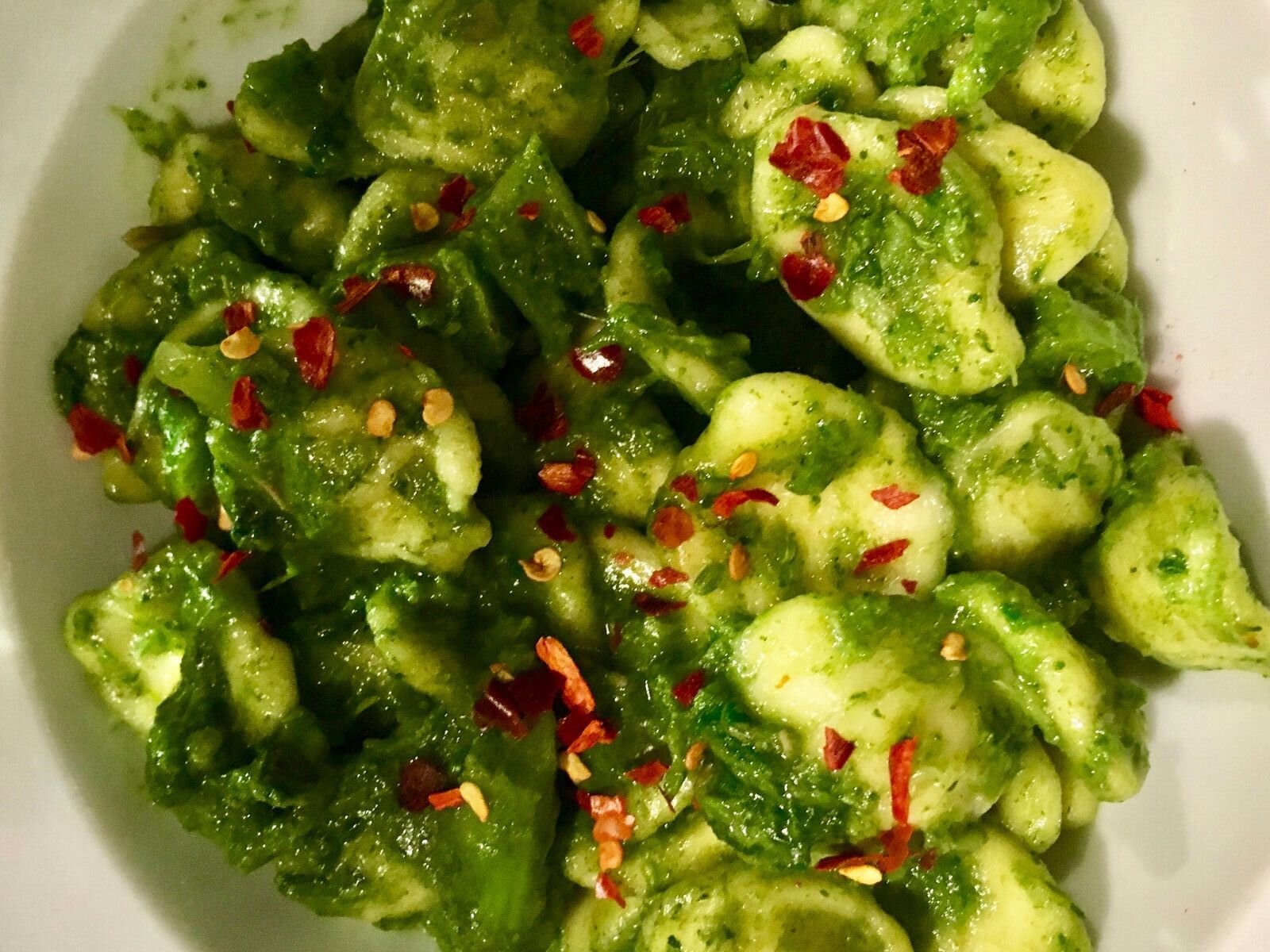Famous Italian pasta dishes
/Within Italy, there’s quite a lot of culinary variety between regions, but one thing’s for sure: you can’t think of Italy without thinking of pasta.
Due to the varied regional traditions in il bel paese, you might find pasta dishes in one area and not in another. Seasonality is also an important factor to keep in mind when visiting Italy. Rather than eating everything all year round, Italian cuisine tends to follow the waves of what’s in season.
All that being said, there are some famous Italian pasta dishes that are well-known all over the boot, twelve of which are detailed in this post.
You might be wondering why lasagna didn’t make the list, or where the gnocchi or ravioli are, but baked pastas, stuffed pastas and pasta-potato hybrids are posts for another day! There’s just too much ground to cover in one post when it comes to pasta in Italy.
Some of the sauces covered here are traditionally paired with certain pasta shapes, and others have a bit more flexibility. Of course, there are exceptions to every rule, but specific shapes have been included in this post where necessary.
Read on for everything you need to know about twelve of the most famous pasta dishes in Italy!
Spaghetti aglio, olio, peperoncino (spaghetti with garlic, oil and chili)
Region of origin: Campania
Given that garlic and peperoncino are grown in the Campania region, and the fact that it produces ten different kinds of extra virgin olive oil, a pasta dish combining all three of these was bound to pop up, right? While it isn’t very common on restaurant menus, this classic is worth ordering if you can find it, if only for the fact that it epitomizes Italian cuisine in one major way: simple ingredients coming together to make something delicious.
Pasta al pomodoro (pasta with tomato sauce)
Region of origin: Campania
Brought to Italy from the New World (modern-day Peru, Bolivia, Chile and Ecuador), tomatoes, as we all know, eventually became one of the most widespread ingredients in Italian cooking. What you might not know is that tomato sauce was first prepared for meat dishes before becoming a staple for pasta.
The first written record of pasta with tomato sauce was in a Neapolitan cookbook from the early 1800s. The original recipe called for tomatoes, garlic, lard or oil, and salt and pepper. It soon became popular throughout the country and the world as a quintessential Italian dish. This is one that you’ll find served with all kinds of pasta shapes.
Penne all’Arrabbiata (penne with tomato and chili sauce)
Region of origin: Lazio
A simple combination of garlic, peperoncino, tomatoes, oil, pecorino romano and parsley, this one is great for anyone who likes a little spice. Arrabbiata means angry in Italian, and the story goes that this dish earned its name because the heat of the peperoncino makes the diner turn red, as if they were angry.
Trofie al pesto (trofie pasta with pesto sauce)
Region of origin: Liguria
Odds are you’re familiar with pesto - the savory combination of creamy pine nuts, olive oil, parmesan cheese and basil that’s worked its way onto chicken and sandwiches outside of Italy but remains firmly on pasta (and sometimes on pizza) within the boot. Nowadays, you’ll find it on different pasta shapes, such as maltagliati (pictured here), but the original preparation called for trofie, a short, twisted pasta, and included cubed potatoes and green beans all tossed in the famous green goodness that is pesto.
Tagliatelle alla Bolognese (tagliatelle pasta with meat sauce)
Region of origin: Emilia Romagna
Sometimes referred to as ragù alla Bolognese, this is one of those dishes that the world has taken from Italy and changed to suit local tastes. You might find versions with mushrooms, cream or chilis, and to be honest, there’s some variation here in Italy, too, but the general gist is the same: ground meat, tomato, celery, carrot, onion, red or white wine, salt and pepper, and generally a small amount of milk or butter.
Another big issue that Italians have with foreigners adapting this dish is that in Italy, ragù alla Bolognese is served with long, flat tagliatelle noodles (or in lasagna), rather than on spaghetti. There are several “Italian” dishes that don’t exist in Italy, and spaghetti alla Bolognese is one of them. So common is it outside of Italy that it’s even known in some countries as “Spag Bol” (I’m looking at you, Australia and the UK).
You’ll find different versions of ragù throughout Italy, which are also worth trying. A few of my favorites are ragù all’anatra (duck), which is from Veneto, and ragù al cinghiale (wild boar) is a famous Tuscan dish.
Spaghetti alla Carbonara (spaghetti with a sauce of eggs, pecorino cheese, and pork cheek)
Region of origin: Lazio
Ubiquitous throughout Rome and Lazio, carbonara is a silky mixture of eggs and pecorino romano cheese that’s punctuated with bits of crunchy, fried guanciale (pork cheek) and black pepper. Sometimes, people make it with pancetta (pork belly) instead of guanciale, but I believe the traditional Roman way calls strictly for guanciale.
The origin story of Carbonara is unclear. Some say it was named for the men who ate carbonara and worked collecting wood to make charcoal, which in Italian is called carbone. Others say it’s because the Allied soldiers asked for bacon and eggs in Italy during World War II, and the locals whipped them up a pasta dish with those ingredients.
What is clear is that you can’t miss this dish when visiting Rome.
Tonarelli cacio e pepe (tonarelli with cheese and pepper)
Region of origin: Lazio
Another Roman classic, tonarelli cacio e pepe are just about as simple as you can get. Cacio means cheese and pepe means black pepper, and they’re the main ingredients of this dish. Tonarelli are long, thick, fresh pasta that are the perfect match for the simple sauce made from melted pecorino romano, black pepper, pasta water, and in some cases, olive oil.
You’ll find thick, creamy versions of cacio e pepe, and others with less cheese that aren’t as rich. You might also find it with seasonal vegetables, such as fava beans or artichokes, mixed in. One thing’s for sure - there’s a cacio e pepe for every taste!
Bucatini all’Amatriciana (bucatini pasta with a tomato and pork cheek sauce)
Region of origin: Lazio
Lazio’s four main pasta dishes (amatriciana, cacio e pepe, gricia and carbonara) are all slight variations of each other. Amatriciana is the tomatoey version, which, like carbonara and gricia, has crispy bites of guanciale and is served with pecorino cheese.
Amatriciana, so named for its town of origin, Amatrice, is traditionally served with bucatini, which are long like spaghetti, but thicker and have a hole down the middle that fills up with the tomato sauce.
In case you’re wondering, gricia is carbonara minus the eggs, or cacio e pepe plus pork cheek – it’s just guanciale, pecorino romano, and black pepper. This is another good one to try if you’re in Lazio!
Spaghetti allo scoglio (spaghetti with mixed seafood)
Region(s) of origin: Sicily, Puglia, Campania
This one’s so delicious that different regions in the south of Italy all want to claim it as their own. Firm spaghetti are the backdrop to this seafood-heavy dish that consists of any combination of mussels, clams, shrimp, calamari, octopus, and perhaps whatever else is fresh. You’ll find versions with tomato and versions without.
Spaghetti allo scoglio is best enjoyed in front of the sea with a bottle of crisp white wine.
Spaghetti alle vongole (spaghetti with clams)
Region of origin: Campania
Simpler than spaghetti allo scoglio, this dish is full of clams rather than mixed seafood. Parsley and oil are added, and, like its fancier cousin, you’ll find versions with and without tomato.
Pasta alla Norma (pasta with eggplant, basil, tomatoes and salted ricotta)
Region of origin: Sicily
Born in Catania, pasta alla norma is a mixture of tomato, fried eggplant, basil and ricotta salata, which is a firm ricotta cheese that is pressed, aged, and salted. This is another one that can be served with various pasta shapes.
Orecchiette con cime di rapa (orecchiette pasta with broccoli rabe)
Region of origin: Puglia
Cime di rapa, or broccoli rabe, are the star of this dish. Sometimes cooked directly with the pasta, these bitter greens are kicked up with chili and, in some cases, anchovies. Orecchiette (little ears) originated in Puglia, and their concave centers are the perfect shape for holding whatever sauce they’re served with.
How many of these famous Italian pasta dishes have you tried? Are there any others that you’d include on this list? Keep in mind that thanks to the traditions of regional and seasonal eating in Italy, you’re likely to find countless delicious pasta dishes to try, so don’t be afraid to go for what’s local and fresh!
Author’s Bio:
The article is written by Molly who lives in Rome and helps people eat and travel well in Italy and beyond at Luggage and Life.
All images are the property of Molly from Luggage and Life.



















